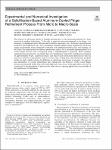Thông tin tài liệu
Thông tin siêu dữ liệu biểu ghi
| Trường DC | Giá trị | Ngôn ngữ |
|---|---|---|
| dc.contributor.author | Curtolo, Danilo | - |
| dc.contributor.author | Schubert, Christian | - |
| dc.contributor.author | Viardin, Alexandre | - |
| dc.date.accessioned | 2023-09-15T07:04:44Z | - |
| dc.date.available | 2023-09-15T07:04:44Z | - |
| dc.date.issued | 2023 | - |
| dc.identifier.uri | https://link.springer.com/article/10.1007/s11661-023-07147-0 | - |
| dc.identifier.uri | https://dlib.phenikaa-uni.edu.vn/handle/PNK/9043 | - |
| dc.description | CC-BY | vi |
| dc.description.abstract | The interest in ultra-pure metals is steadily growing due to the increasing demand for these materials in modern technology. To be able to meet the increasing demand in the future, it is necessary to implement more efficient and productive processes. As a fractional crystallization method in this application area, the cooled finger method exhibits higher productivity and lower energy requirements when compared to industry well-established methods like zone melting. In this study, the mechanisms and relevant phenomena crucial for a successful implementation of a cooled finger process were investigated using a multidisciplinary approach. With carefully selected process parameters, we present here an experimental setup with a purification potential of approximately 80 pct. | vi |
| dc.language.iso | en | vi |
| dc.publisher | Springer | vi |
| dc.subject | fractional crystallization method | vi |
| dc.title | Experimental and Numerical Investigation of a Solidification-Based Aluminum-Cooled Finger Refinement Process From Micro to Macro-Scale | vi |
| dc.type | Book | vi |
| Bộ sưu tập | ||
| OER - Khoa học Vật liệu, Ứng dụng | ||
Danh sách tệp tin đính kèm:

